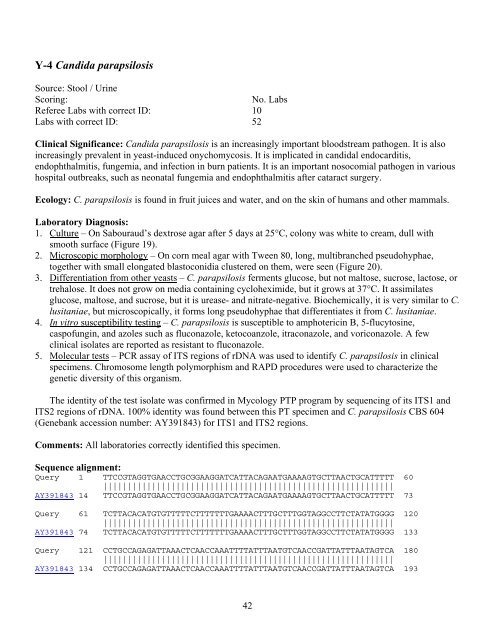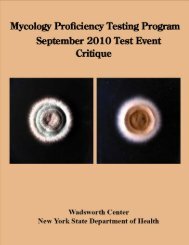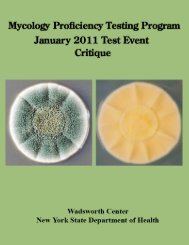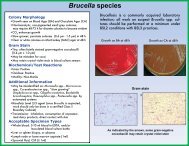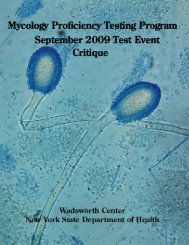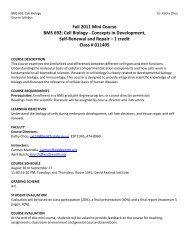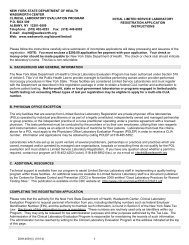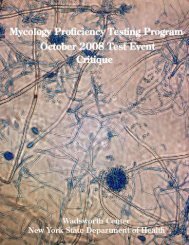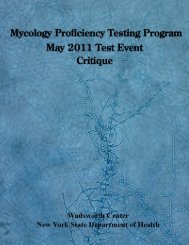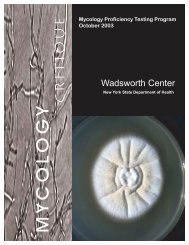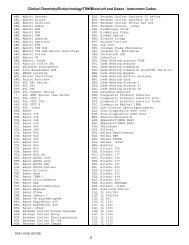Y-4 Candida parapsilosisSource: Stool / UrineScoring:No. LabsReferee Labs with correct ID: 10Labs with correct ID: 52Clinical Significance: Candida parapsilosis is an increasingly important bloodstream pathogen. It is alsoincreasingly prevalent in yeast-induced onychomycosis. It is implicated in candidal endocarditis,endophthalmitis, fungemia, and infection in burn patients. It is an important nosocomial pathogen in varioushospital outbreaks, such as neonatal fungemia and endophthalmitis after cataract surgery.Ecology: C. parapsilosis is found in fruit juices and water, and on the skin of humans and other mammals.Laboratory Diagnosis:1. Culture – On Sabouraud’s dextrose agar after 5 days at 25°C, colony was white to cream, dull withsmooth surface (Figure 19).2. Microscopic morphology – On corn meal agar with Tween 80, long, multibranched pseudohyphae,together with small elongated blastoconidia clustered on them, were seen (Figure 20).3. Differentiation from other yeasts – C. parapsilosis ferments glucose, but not maltose, sucrose, lactose, ortrehalose. It does not grow on media containing cycloheximide, but it grows at 37°C. It assimilatesglucose, maltose, and sucrose, but it is urease- and nitrate-negative. Biochemically, it is very similar to C.lusitaniae, but microscopically, it forms long pseudohyphae that differentiates it from C. lusitaniae.4. In vitro susceptibility testing – C. parapsilosis is susceptible to amphotericin B, 5-flucytosine,caspofungin, and azoles such as fluconazole, ketocoanzole, itraconazole, and voriconazole. A fewclinical isolates are reported as resistant to fluconazole.5. Molecular tests – PCR assay of ITS regions of rDNA was used to identify C. parapsilosis in clinicalspecimens. Chromosome length polymorphism and RAPD procedures were used to characterize thegenetic diversity of this organism.The identity of the test isolate was confirmed in Mycology PTP program by sequencing of its ITS1 andITS2 regions of rDNA. 100% identity was found between this PT specimen and C. parapsilosis CBS 604(Genebank accession number: AY391843) for ITS1 and ITS2 regions.Comments: All laboratories correctly identified this specimen.Sequence alignment:Query 1 TTCCGTAGGTGAACCTGCGGAAGGATCATTACAGAATGAAAAGTGCTTAACTGCATTTTT 60||||||||||||||||||||||||||||||||||||||||||||||||||||||||||||AY391843 14 TTCCGTAGGTGAACCTGCGGAAGGATCATTACAGAATGAAAAGTGCTTAACTGCATTTTT 73Query 61 TCTTACACATGTGTTTTTCTTTTTTTGAAAACTTTGCTTTGGTAGGCCTTCTATATGGGG 120||||||||||||||||||||||||||||||||||||||||||||||||||||||||||||AY391843 74 TCTTACACATGTGTTTTTCTTTTTTTGAAAACTTTGCTTTGGTAGGCCTTCTATATGGGG 133Query 121 CCTGCCAGAGATTAAACTCAACCAAATTTTATTTAATGTCAACCGATTATTTAATAGTCA 180||||||||||||||||||||||||||||||||||||||||||||||||||||||||||||AY391843 134 CCTGCCAGAGATTAAACTCAACCAAATTTTATTTAATGTCAACCGATTATTTAATAGTCA 19342
Query 181 AAACTTTCAACAACGGATCTCTTGGTTCTCGCATCGATGAAGAACGCAG 229|||||||||||||||||||||||||||||||||||||||||||||||||AY391843 194 AAACTTTCAACAACGGATCTCTTGGTTCTCGCATCGATGAAGAACGCAG 242Alignment of primary sequence of the ITS1 regions of C. parapsilosis CBS 604 and PT specimen C. parapsilosis NYSDOH 0907.Query 1 GCATCGATGAAGAACGCAGCGAAATGCGATAAGTAATATGAATTGCAGATATTCGTGAAT 60||||||||||||||||||||||||||||||||||||||||||||||||||||||||||||AY391843 224 GCATCGATGAAGAACGCAGCGAAATGCGATAAGTAATATGAATTGCAGATATTCGTGAAT 283Query 61 CATCGAATCTTTGAACGCACATTGCGCCCTTTGGTATTCCAAAGGGCATGCCTGTTTGAG 120||||||||||||||||||||||||||||||||||||||||||||||||||||||||||||AY391843 284 CATCGAATCTTTGAACGCACATTGCGCCCTTTGGTATTCCAAAGGGCATGCCTGTTTGAG 343Query 121 CGTCATTTCTCCCTCAAACCCTCGGGTTTGGTGTTGAGCGATACGCTGGGTTTGCTTGAA 180||||||||||||||||||||||||||||||||||||||||||||||||||||||||||||AY391843 344 CGTCATTTCTCCCTCAAACCCTCGGGTTTGGTGTTGAGCGATACGCTGGGTTTGCTTGAA 403Query 181 AGAAAGGCGGAGTATAAACTAATGGATAGGTTTTTTCCACTCATTGGTACAAACTCCAAA 240||||||||||||||||||||||||||||||||||||||||||||||||||||||||||||AY391843 404 AGAAAGGCGGAGTATAAACTAATGGATAGGTTTTTTCCACTCATTGGTACAAACTCCAAA 463Query 241 ACTTCTTCCAAATTCGACCTCAAATCAGGTAGGACTACCCGCTGAACTTAAGCATATCAA 300||||||||||||||||||||||||||||||||||||||||||||||||||||||||||||AY391843 464 ACTTCTTCCAAATTCGACCTCAAATCAGGTAGGACTACCCGCTGAACTTAAGCATATCAA 523Query 301 TAAGCGGAG 309|||||||||AY391843 524 TAAGCGGAG 532Alignment of primary sequence of the ITS2 regions of C. parapsilosis CBS 604 and PT specimen C. parapsilosis NYSDOH 0907.Further Reading:1. David, A., Risitano, D.C., Mazzeo, G., Sinardi, L., Venuti, F.S., and Sinardi, A.U. 2005. Central venouscatheters and infections. Minerva Anestesiol. 71: 561-564.2. Da Silva, C.L., dos Santos, R.M., and Colombo, A.L. 2001. Cluster of Candida parapsilosis primarybloodstream infection in a neonatal intensive care unit. Braz. J. Infect. Dis. 5: 32-36.3. Deshpande, K. 2003. Candida parapsilosis fungaemia treated unsuccessfully with amphotericin B andfluconazole but eliminated with caspofungin: a case report. Crit Care Resusc. 5: 20-23.4. Filioti, J., Spiroglou, K., and Roilides, E. <strong>2007</strong>. Invasive candidiasis in pediatric intensive care patients:epidemiology, risk factors, management, and outcome. Intensive Care Med. 33: 1272-1283.5. Garzoni, C., Nobre, V.A., and Garbino, J. <strong>2007</strong>. Candida parapsilosis endocarditis: a comparative reviewof the literature. Eur J Clin Microbiol Infect Dis. Sep 6; [Epub ahead of print]6. Jones, J.M., Sarsam, M.A., Clarke, M.A., and Hedderwick, S.A. 2002. Candida parapsilosis: two casesof endocarditis in association with the Toronto stentless porcine valve. J. Infect. 44: 196-198.7. Lopez-Ciudad, V., Castro-Orjales, M.J., Leon, C., Sanz-Rodriguez, C., de la Torre-Fernandez, M.J.,Perez de Juan-Romero, M.A., Collell-Llach, M.D., Diaz-Lopez, M.D. 2006. Successful treatment ofCandida parapsilosis mural endocarditis with combined caspofungin and voriconazole. BMC Infect Dis.16: 73.43
- Page 3 and 4: CONTENTSContents 3Schedules 4Test S
- Page 6 and 7: A failure to attain an overall scor
- Page 8 and 9: LABORATORY PERFORMANCE SUMMARYMycol
- Page 10 and 11: MOLD DESCRIPTIONSM-1 Malbranchea sp
- Page 12 and 13: 3. Kaufman, L., Standard, P.G., Hup
- Page 14 and 15: A. B.Figure 1. (A) One-week-old col
- Page 16 and 17: Query 121 GTCCGCCGGGGAAAACCAAACCCTG
- Page 18 and 19: A. B.Figure 3. (A) Seven-day-old, p
- Page 20 and 21: ectangular, of the same diameter as
- Page 22 and 23: TABLE 2: Differentiation of Chrysos
- Page 24 and 25: M-4 Fusarium sp.Source: NailsScorin
- Page 26 and 27: A. B.Figure 7. (L) Seven-day-old, w
- Page 28 and 29: A. B.Figure 9. (A) Seven-day-old, w
- Page 30 and 31: Query 180 TTGGTTCTGGCATCGATGAAGAACG
- Page 32 and 33: YEAST DESCRIPTIONSY-1 Candida dubli
- Page 34 and 35: Alignment of primary sequence of th
- Page 36 and 37: Y-2 Rhodotorula minutaSource: Cathe
- Page 38 and 39: Figure 15. Seven-day-old, soft, smo
- Page 40 and 41: Sequences alignment:Query 1 TCCGTAG
- Page 44 and 45: 8. Yalaz, M., Akisu, M., Hilmioglu,
- Page 46 and 47: Y-5 Trichosporon asahiiSource: Bloo
- Page 48 and 49: 5. Panagopoulou, P., Evdoridou, J.,
- Page 50 and 51: ANTIFUNGAL SUSCEPTIBILITY TESTINGIn
- Page 52 and 53: DIRECT DETECTION (CRYPTOCOCCUS NEOF
- Page 54 and 55: Table 4. Summary of quantitative as
- Page 56 and 57: 25. Rebell, G. and Taplin, D. 1972.


